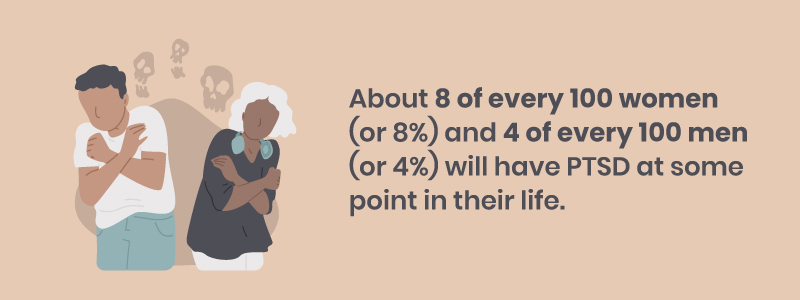Comprehensive Guide to PTSD Treatment: Approaches and Strategies
Table of Contents
Understanding PTSD
Post-traumatic stress disorder (PTSD) is a mental health condition that can develop in people who have experienced or witnessed a traumatic event. Finding comprehensive PTSD treatment is imperative for long-term healing.
Traumatic events that could cause PTSD may involve actual or threatened death, serious injury, accidents, natural disasters, or sexual violence. PTSD is characterized by symptoms that persist for an extended period after the traumatic event.1
Over 70% of American adults have experienced some type of traumatic event in their life. While not everyone develops PTSD, these symptoms can significantly impact a person’s daily life, emotions, and overall well-being.2

Questions About Treatment?
Let us guide you through your options and treatment opportunities. Contact Alternative Options today.
Symptoms of PTSD
- Intrusive Thoughts: These involve re-experiencing the traumatic event through distressing memories, nightmares, or flashbacks.
- Avoidance: Individuals with PTSD often try to avoid reminders of the traumatic event, including places, people, or associated activities.
- Negative Alterations in Cognition and Mood: This includes feelings of guilt, shame, emotional numbness, and negative changes in beliefs about oneself or the world.
- Arousal and Reactivity: Symptoms in this category include irritability, difficulty sleeping, exaggerated startle response, and hyper-vigilance.
Overview of PTSD
Prevalence and Incidence Rates of PTSD
PTSD is a relatively common mental health condition. Its prevalence can vary based on factors such as the type of trauma, demographics, and cultural contexts. The rates of PTSD can differ between populations exposed to different types of traumatic events.
Common Causes and Risk Factors
- Combat exposure: Military personnel who have experienced combat situations may develop PTSD due to the intense stress and life-threatening situations they face.
- Sexual assault or abuse: Survivors of sexual assault or abuse can develop PTSD due to the trauma and violation they’ve experienced.
- Natural disasters: Individuals who have lived through earthquakes, hurricanes, wildfires, and other natural disasters can be at risk for PTSD.
- Serious accidents: People who have survived car crashes, industrial accidents, or other life-threatening incidents may also develop PTSD.
- Witnessing violence: Individuals who have witnessed violent acts, such as shootings or acts of terrorism, may also develop PTSD.

The Connection Between PTSD and Substance Use Disorder
Coping Mechanisms
Many individuals with PTSD may turn to substances to cope with their disorder’s distressing symptoms. Drugs or alcohol can temporarily relieve anxiety, depression, and other overwhelming emotions associated with PTSD.
Self-Medication
Some individuals may unintentionally engage in self-medication, using substances to numb emotional pain or suppress intrusive thoughts and memories related to trauma.
Biological Factors
Cycle of Self-Destruction
Treatment Challenges
How Dual Diagnosis Treatment Can Help

PTSD and Other Co-Occurring Disorders
These complications often interact intricately, highlighting the importance of a comprehensive treatment approach. Here are some other common co-occurring disorder that can arise alongside PTSD:
Depression
Anxiety Disorders
PTSD frequently co-occurs with other anxiety disorders, such as generalized anxiety disorder, panic disorder, and specific phobias. The persistent fear and heightened arousal characteristic of PTSD can overlap with symptoms of these disorders.
Sleep Disturbances
Physical Health Issues
Cognitive Impairment
Relationship Challenges
Suicidal Ideation

Diagnosing PTSD
Clinical Interview
The initial step involves a comprehensive clinical interview where the mental health professional converses with the individual. They discuss the individual’s symptoms, experiences, trauma history, and other relevant factors.
Diagnostic Criteria
Assessment Tools
Trauma History
Duration and Impairment
Rule Out Other Conditions
Cultural Considerations
Patient's Perspective
Warning Signs of PTSD
PTSD Treatment Approaches
Psychotherapy
Cognitive-Behavioral Therapy (CBT)
Exposure Therapy
Eye Movement Desensitization and Reprocessing (EMDR)
Prolonged Exposure Therapy
Medication
- Antidepressants: Selective serotonin reuptake inhibitors (SSRIs) and serotonin-norepinephrine reuptake inhibitors (SNRIs) are commonly prescribed. These medications help regulate mood and anxiety by affecting neurotransmitter levels in the brain. They have shown promise in alleviating PTSD symptoms and improving the overall quality of life.
- Anti-Anxiety Medications: Benzodiazepines and Buspirone are sometimes prescribed to manage acute anxiety and panic symptoms. However, these medications are typically used cautiously due to the risk of dependence and potential side effects.
Medication for PTSD
Complementary and Alternative Therapies
Yoga and Meditation
Acupuncture
Animal-Assisted Therapy
Animal companionship has been shown to provide comfort and emotional support for individuals with PTSD. Equine-assisted therapy has been particularly effective in helping patients build trust, reduce anxiety, and enhance emotional regulation.
Personalized and Holistic Approaches to PTSD Treatment
Importance of Individualized Treatment Plans
Incorporating Patient Preferences and Cultural Considerations
Addressing Co-Occurring Conditions and Holistic Well-Being
- Tailoring evidence-based therapies: Combining different therapeutic modalities to address specific symptoms and needs.
- Medication management: Adjusting medications based on individual responses and considering interactions with other treatments.
- Lifestyle factors: Addressing sleep, exercise, nutrition, and other factors impacting mental health.
- Social support: Engaging family, friends, and support networks in treatment.
- Self-care strategies: Teaching coping skills, relaxation techniques, and self-compassion practices.

PTSD Treatment at Alternative Options
What Do We Offer?
- Family therapy
- Trauma-informed therapy
- CBT and DBT
- Trauma focused groups
- Art and music therapy
- Diagnostic testing
Get in Touch Today
Reach out for holistic PTSD treatment today.
Resources
1 https://www.psychiatry.org/patients-families/ptsd/what-is-ptsd
2 https://www.thenationalcouncil.org/wp-content/uploads/2022/08/Trauma-infographic.pdf
4 https://www.nimh.nih.gov/health/topics/post-traumatic-stress-disorder-ptsd
5 https://www.ptsd.va.gov/professional/treat/cooccurring/index.asp
6 https://www.ptsd.va.gov/professional/treat/cooccurring/tx_sud_va.asp
7 https://www.healthline.com/health/ptsd-and-depression#having-both



